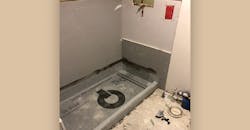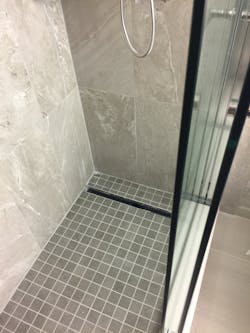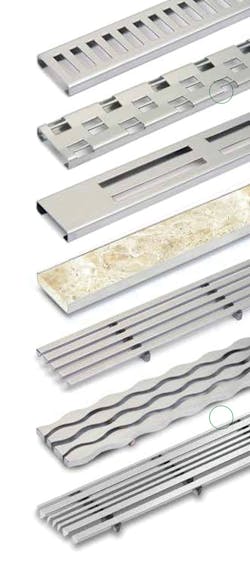You might have noticed in your pre-pandemic travels that hotels are moving away from tub/shower combinations to walk-in showers. Showers are the new “norm” in hotels, notes Walter “Bo” Dean, owner of New Caney, Texas-based Hospitality Innovations Inc., which provides renovation services exclusively to hotels and resorts across the country.
“Tub-to-shower conversions are a standard in today’s times,” he says. “Most of the hotels that we renovate have tub-to-shower conversions.”
Hotels focus on three factors when transitioning tub/showers to showers only: guest preference, safety and energy efficiency.
Most people take showers rather than soaking baths, so if a hospitality property caters more to business clientele, a walk-in shower makes more sense. Destination resorts, however, cater to a different kind of guest, so tub/showers may be more practical. Separate bathtub and shower areas can seem more luxurious in a deluxe suite.
Safety comes into play with older guests and people with disabilities or others recovering from an accident—curbless walk-in showers are much easier for everyone to use as there’s nothing to step or trip over. Not only are they ADA-compliant, but walk-in showers also are in line with universal design concepts.
And showers typically use less hot water than bathtubs, so energy conservation is a big plus.
Problems with off-center drains
The Houston Marriott Medical Center Hotel, located within minutes to major destinations in Houston, wanted to convert 400 bathtubs into modern curbed showers. Hospitality Innovations won the bid for the renovation contract.
“The renovation at the Medical Center Marriott was a full bathroom remodel and consisted of removing the existing plumbing fixtures, vanities, light fixtures, wall finishes, floor tile, wall tile, bathtubs and bathroom doors,” Dean explains. “We updated the bathrooms with a modern look supplied by designers.”
He adds that the first step in a tub-to-shower conversion is to remove the wall tile and bathtub. The crew then installs a new shower base and connects it to the room below according to local codes, covers the walls and adds the preferred visual finish.
Hospitality Innovations converted 175 tubs to showers using one-piece surface shower pans, but as the four-man crew began removing more old tubs, they discovered that post-tension cables were used in the hotel's multilevel construction. Also, a substantial number of drains were off-center. As a result, the previously specified pre-formed pans were no longer suitable and too costly to customize for the application.
"Ultimately, we were unable to jack-hammer or core-drill through the concrete to adjust the drains’ positioning to use the pre-formed pans," Dean says. "That’s because we would've compromised those slabs.”
Instead, the Hospitality Innovations crew used tub-to-shower conversion kits. "I was aware that QuickDrain had multiple drain connection styles and knew the on-site, adjustable PET shower pans would allow us to adapt to numerous jobsite irregularities, including unexpected plumbing configurations," Dean explains.
The HI crew installed 225 walk-in showers—with minimal disruptions to hotel guests—using QuickDrain USA's ShowerLine linear shower drain system. Instead of a four-way compound slope toward the drain, it requires only a one-directional slope. This improves drainage, giving water one uniform path toward the drain, minimizing installation errors.
Water exits through either a vertical or a side waste outlet, making it easy to accommodate existing plumbing. For the Medical Center Hotel applications, water exits through 1 1/2-in. side waste outlets.
The architect and design team at the Marriott opted for the polished stainless-steel drain cover (one of six options).
A QuickDrain technical applications specialist provided on-site technical support to Dean and his team at the Houston Marriott Medical Center Hotel. "Although my guys were pretty familiar with the installation process, we welcomed the opportunity to have the manufacturer on-site," he says. "It ensures that we're aware of new updates or any additional insights that could help us in the future."
Saving time saves money
Dean spent 15 years installing carpet and tile before he opened Hospitality Innovations in 2015. The company has five employees and uses subcontractors all across the country.
“With great mentors and a desire to produce exceptional products, I have always been on the forefront of technology in shower bases, waterproofing and crack suppressions,” he notes. “Obviously, when you have 600 guestrooms to install pre-slope shower liner and mud pack, you are always looking for a great solution to save money and time.”
The traditional way to install a shower base involves pouring a mortar bed, sloping it down to the drain and waiting for it to dry—a three-day process per shower. But time is of the essence in the hospitality industry; rooms under construction can’t be rented out.
"My guys were so efficient, they were installing 10 drains a day, on average, conducting full installations and leaving the hotel room below completely in service,” Dean explains. “And installing 10 drains a day is comparable to the installation time of the previously specified pre-formed pan product. We not only saved costs in terms of labor but, most importantly, we saved time. The shower pans were easy to install to make the transition from a tub to a shower."
The HI crew began in June 2019 and finished work in October of that year. “The clients loved the shower bases,” Dean says. “They were a great solution to a bad situation.”
Kelly Faloon is a contributing writer to CONTRACTOR magazine. The former editor of Plumbing & Mechanical magazine, she has more than 30 years’ experience in B2B publishing; 22 of those years were spent covering the plumbing, heating, cooling and piping industry. A native of Michigan’s northern Lower Peninsula, Faloon is a journalism graduate of Michigan State University.
About the Author

Kelly L. Faloon
Freelance Writer/Editor
Kelly L. Faloon is a contributing editor and writer to Contractor, Contracting Business magazine and HPAC Engineering and principal of Faloon Editorial Services. The former editor of Plumbing & Mechanical magazine, Faloon has more than 26 years of experience in the plumbing and heating industry and more than 35 years in B2B publishing. She started a freelance writing and editing business in 2017, where she has a varied clientele.
Faloon spent 3 1/2 years at Supply House Times before joining the Plumbing & Mechanical staff in 2001. Previously, she spent nearly 10 years at CCH/Wolters Kluwer, a publishing firm specializing in business and tax law, where she wore many hats — proofreader, writer/editor for a daily tax publication, and Internal Revenue Code editor.
A native of Michigan’s northern Lower Peninsula, Faloon is a journalism graduate of Michigan State University. You can reach her at [email protected].


